#Egyptians: Wepwawet is that you
Explore tagged Tumblr posts
Text
Ok but...

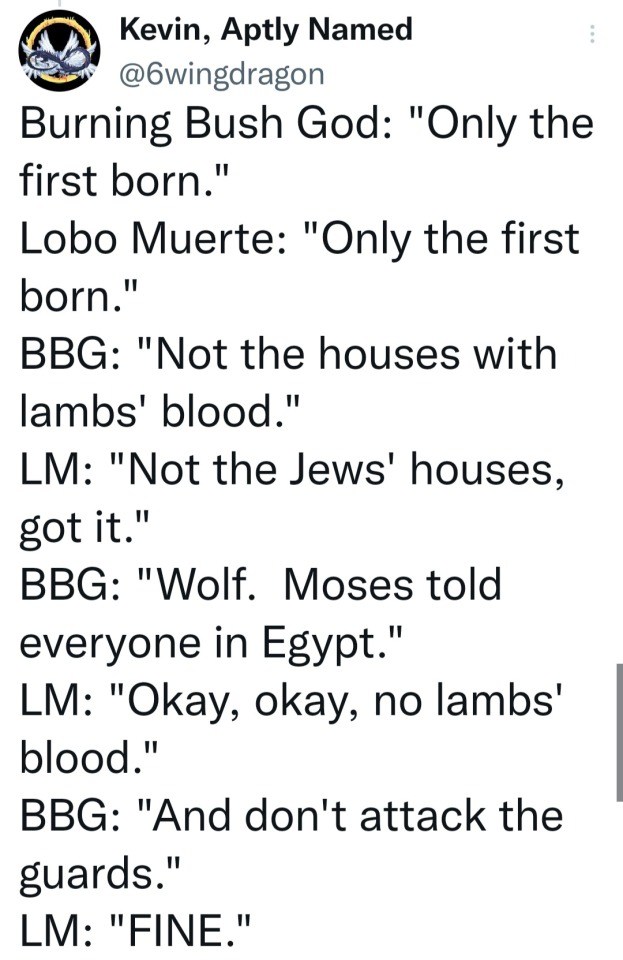
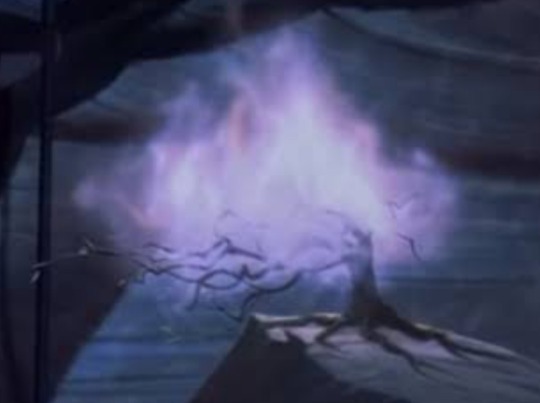

I can see this happening HELP
#Egyptians: Wepwawet is that you?#dreamworks#puss in boots#puss in boots 2#puss in boots the last wish#pib#pib 2#pib tlw#lobo muerte#death wolf#pib lobo#puss in boots lobo#puss in boots wolf#pib wolf#death the wolf#puss in boots death#pib death#prince of egypt#the prince of egypt#the angel of death#angel of death#moses#burning bush#i guess biblically accurate death wolf is a thing now
686 notes
·
View notes
Text
My Reiki Attunement Ceremony

"When you see the Southern Cross for the first time You understand now why you came this way Cause the truth you might be running from is so small But it's as big as the promise The promise of a coming day"
Crosby, Stills & Nash - "Southern Cross"
On March 24, 2022 I drove from the house of a friend I was living with at the time to Karen Wilson’s house on Padre Island. I was talking to my husband-then-boyfriend on Google Duo as I drove over the bridge towards Flour Bluff. I felt calm yet vibrated with excitement. As I parked in front of Karen’s house I told my boyfriend I loved him and said I’ll call him afterwards. I would be a very different person the next time we talked.
Karen led me into her office and we spoke for a bit before proceeding to her Reiki room. As I laid down on the table she invited any Guides who wished to be present. Immediately the room was full as many Netjeru visibly manifested for me. I impulsively said, “holy crap, there’s a lot of Them!” Karen backpedaled a bit and with a laugh explained that this was a sacred ceremony that required a bit of decorum. I laughed nervously and laid back down as she began working on my Crown.
To the far left I saw Set and Heru-Wer (Horus the Elder). Standing side by side, They looked very much like brothers. Set was cocky and proud, His smile toothy and wide. Heru-Wer was stoic and severe, yet He had a small smile on His beak. To the far right I saw Yinepu (Anubis) and Wepwawet (Upuaut). They have been shamanic guides for me in the past. In the center stood Aset (Isis), Djehuty (Thoth), Sekhmet, Bast, and Mafdet. I was very surprised then to see Aset as I felt estranged from Her husband Asar (Osiris). I assumed She didn’t like me very much. And Mafdet was a surprise as well, for I wasn’t quite sure how She related to me. Shu and Tefnut were in the back against the wall. Geb was the floor below and Nuit was the ceiling above. They were all practically beaming and it felt like a graduation, though it took me a while to begin to understand just what that meant.
As I lay on the table my mind began to wander. Quickly, Djehuty appeared in the forefront of my vision with an admonishing glance. He explained that this was a sacred ceremony and demanded I give it the proper respect it deserved. Sheepishly, I apologized with a glance. Djehuty gave me a very curious look, the knowing sort of look a patient schoolteacher gives the student who apologizes after getting a reprimand for misbehavior, a kind of feigned way of saying, “I’ve got my eye on you.” With a cheeky smile He returned to the rest of the group and I immersed myself back into the experience.
About halfway through Bast and Sekhmet had stepped forward. Bast held my left hand and Sekhmet my right, each looking down at me with a smile. They soon each put their free hands on my shoulders. Their touch was warm and soft and I saw nothing but love and pride in Their eyes.
As Karen began speaking Light Language at my feet I was immersed in a series of visions. I was shown my room as it was when I was a baby. I had forgotten the off-white color the walls used to be before my dad painted it sky blue. I was on my back in my crib and Aset was leaning over the rails, singing to me. She appeared as the Divine Mother, wearing a flowing white gown with long, flowing black hair and an ample bosom. She wore the Uraeus crown on Her forehead, made of gold inlaid with blue and green stones of rectangular cut.
The scene shifted to the first dark day of my life. My mom had a cerebral aneurysm a month before my third birthday. As the paramedics took her away, Aset and Her sister, Nebt-Het (Nephthys) had wrapped Their arms around me as Sekhmet and Bast looked on. In Bast I saw love and a twinkle in Her eye. In Sekhmet I saw fierce devotion, a mother lioness determined to protect Her cub.
Again the scene shifted to a few days later. After my dad picked me up from staying with a neighbor, we found a litter of kittens in the side yard. We kept one cat that I named Jimmy and gave the others to family friends. As a grew, I suspected Bast had something to do with it. In that moment, I saw Her speaking to the kittens with that feisty glint in Her eye. I was too young to know it but Jimmy and I needed each other.
Again the scenes shifted, more rapidly. When I was being mischievous or too smart for my own good, Set was there egging me on. When I was writing in the workbooks my dad made me do before starting preschool (thank you for that, dad), Djehuty was looking over my work and pointing out corrections. These were affirmations that throughout my entire life They were with me. I was never, ever alone. Even when my higher senses were shut down and during every dark night of the soul, They never left my side. That is why I have the utmost loyalty and respect for the Netjeru.
After the ceremony, Karen laid on the table and had me practice Reiki on her. I could feel it, the energy coursing through my bloodstream. It felt like a miniature River of Light coursing through me, a holographic emanation of the very soul of the Cosmos. Karen told me to relax a bit, to open up my Heart and Crown chakras. I did so and the flow began to surge. I had performed my role as a Reiki Practitioner for the very first time.
I realized something profound at the end. As I got in the car and called my boyfriend, I told him everything that happened. And I told him what I had realized; it was so simple, but it had eluded me my entire life. If Reiki is the Light of the Source, the First Energy called Love, and the Source is the Pythagorean Monad, what the Gnostics called the Godhead or what some today call the Divine, the One or the Self, then there is utter truth in the statement “God loves us.” I felt like a lifetime of weight, from my upbringing in Texas to being abused and bullied by those claiming to be devout Christians, just disappeared. In that wonderful Light, their actions didn’t matter. I was given a profound gift that can never be taken away.
Image is a painting in the tomb of Sennedjem, in Thebes, Egypt depicting Yinepu preparing a mummy for burial. The way His hands are placed on the mummy just feels… familiar.
#reiki#reikihealing#reikienergy#netjeru#egyptian gods#kemetic#kemeticism#kemetism#you are loved#bast#bastet#sekhmet#thoth#djehuty#anubis#wepwawet#horus#isis goddess#tefnut#spiritual awakening#spiritual growth#spiritual healing
13 notes
·
View notes
Text
I keep seeing polls made for people unfamiliar with a piece of media to ask them to try and identify the thing that does not happen in said media, and I always thought those looked like a lot of fun! So, I decided to make one, and I already knew the perfect franchise for one: The World of Darkness (WoD) TTRPG franchise. The WoD is a franchise containing several different TTRPG’s about playing as monsters, and it has some of the most unhinged lore I have ever come across.
Almost everything above is heavily simplified for the sake of fitting into the poll boxes btw. Also, I promise that this is not a trick. Ten of the Eleven options presented above actually are a part of this franchises seemingly infinite Metaplot. I’ll schedule a reblog containing the answer and some much needed context for everything above.
#tumblr polls#polls#World of Darkness#vampire the masquerade#werewolf the apocalypse#mage the ascension#changeling the dreaming#demon the fallen#wraith the oblivion#a certified themainspoon classic
489 notes
·
View notes
Note
I love the fic! For the cat darling is gender neutral okay?
The were cats are more like a rare entity that claims power from the moon but have like 9 lives based on Bastet and have more alchemy than strength.
(Here's the fic this anon is referencing: fic)
Yes! I try to make most of my reader inserts gender neutral, so that includes cat darling, too!
I really love the idea of werecat!reader being associated with Bastet and the moon since werewolves are also very heavily associated with the moon! I think it'd be cool if the werewolves in this particular universe were based on Wepwawet, an Egyptian deity that's depicted as a wolf! Werecats are better with alchemy and werewolves are better with strengths, so they balance each other out.
The potential (soft) angst with the nine lives would be sooo fun to explore, too. Maybe you get hurt one day, your body lifeless as blood pools around you. Vilkas doesn't think he's ever seen so much blood and he's never expected it to come from you. He cradles you in his arms, your skin feeling so cold against his. It makes his mind freeze over, uncertain of what to do. You can't be gone.
"Why're you crying?" your tired voice asks, breaking him out of his mental fog. He stares down at you, wide eyed. You're still bleeding, you're still hurt, but... you're alive.
Oh, thank the moon, really. He doesn't care about how you're still here, just that you are. After all, he doesn't know what he would've done if you were truly, truly gone.

#Vilkas Lunewood Tsuu OC#Tsuuper OCs#werewolf oc x reader#werewolf oc#monster boy#werewolf x you#werewolf x reader
81 notes
·
View notes
Text
Werewolf Fact #75 - Cynocephali (dog-headed men)
This month's folklore fact is a long-awaited one from over on the Patreon: the cynocephali or "dog-headed men."
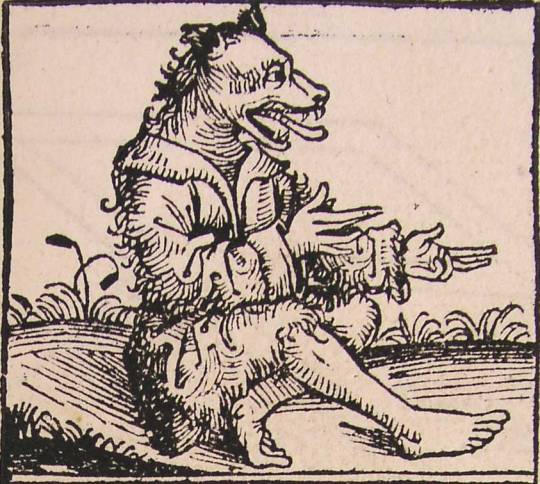
Some depictions of cynocephali (the one above is from the Nuremberg Chronicle, 1493) are mistaken for werewolves fairly frequently; there are several differences of note, including but not limited to the fact that they are otherwise very, very human (normal hands and feet, no tail, etc) and that their ears are not always shaped like a wolf's/pointing directly upright. They often are, however, so don't take the ear shape as a surefire thing, either. When in doubt, make sure the depiction is actually meant to be showing a werewolf before using it for, I don't know, a royalty-free image in your werewolf publication (I've seen several). The cynocephali do not shapeshift, nor are they associated with wolves. They have nothing to do with werewolves. Yes, it was just a plot to make you click this link and read about cynocephali.
Cynocephali, or singular cynocephalus, is a term derived from the original Greek word "kynokephaloi," meaning "dog-headed." They have other names as well, which mean a range of things such as "dog-faced" and "half-dog." They were mentioned in assorted accounts and tales of travelers in Africa and India, appearing in sources as old as ancient Greece, and some similar beings can be found in other cultures, such as China. Likewise, depictions of and discussions of such beings continue into the Middle Ages. This same term was later used to refer to baboons, to which no-fun modern day scholars now attribute all cynocephali legends (although we do have at least one Ottoman depiction of a cynocephalus battling a monkey).
There are many quotes across various sources and time periods about these beings, including but not limited to this one from the fifth century BC Greek historian Herodotus, Histories 4. 191. 3 (trans. Godley) [source: Theoi]
"For the eastern region of Libya, which the Nomads inhabit, is low-lying and sandy as far as the Triton river; but the land west of this, where the farmers live, is exceedingly mountainous and wooded and full of wild beasts. In that country are the huge snakes and the lions, and the elephants and bears and asps, the horned asses, the Kunokephaloi (Cynocephali) (Dog-Headed) and the Headless Men that have their eyes in their chests, as the Libyans say, and the wild men and women, besides many other creatures not fabulous."
Some stories of the cynocephali are also frightfully specific as to how they live, rear livestock, grow fruit, weave baskets, wage war, and much more, even including details of their society, clothing, how long they live, etc. It's all quite interesting. If you'd like to read more specific quotations, you can find many on one of my favorite websites, Theoi.
Sources seem to dispute one another as to whether they bark, do not bark but only howl, only shriek, or whatever other sounds they may make, and there is also a range of descriptions including elements such as if they have beards and whether hair covers their bodies as well as the dog-head. Overall, probably the majority of sources say they wear the skins of animals as opposed to having fur, but there are those that also call them hairy all over.
Please note that I will not be covering/discussing any gods from ancient Egypt in this post, because despite what some modern day scholars like to discuss, I don't consider them "cynocephali." They were wolf-headed deities, not dog-headed (or even jackal-headed), and are overall only related to cynocephali legends by proxy and by modern scholars always putting everything into blasted categories for their next thesis. There were some dog-headed deities in ancient Egypt, and Anubis, Wepwawet, Duamutef, etc, were not among them, and even then, we can't really assert that the dog-headed deities among the ancient Egyptians are actually related to other legends and records of cynocephali.
With that out of the way, let's continue...
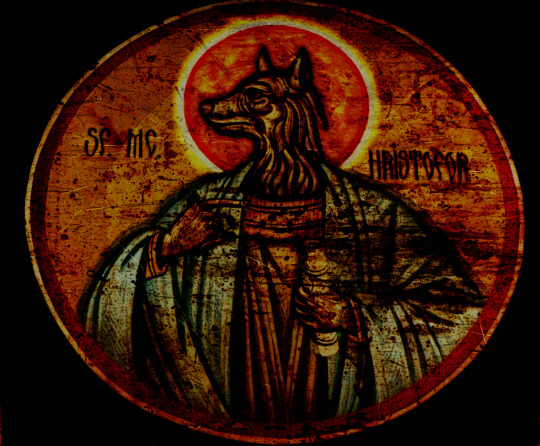
One of my personal favorite stories involving a dog-headed man is a version of the tale of Saint Christopher, though these depictions and this tale are not seen as canon by churches and has been proscribed in Eastern Orthodoxy (where such depictions were generally most common). Some of these depictions still survive, however. Some sources believe that Byzantine depictions of a dog-headed Christopher come from mistaking "Cananeus" (meaning "Canaanite") for "caninus," i.e. canine.
In the story about a dog-headed Saint Christopher, there lives Reprebrus (among other variations of his name; ultimately, they all essentially mean "reprobate"), who is captured by Romans in battle and made to serve among them. Reprebrus was said to be of "enormous size," with the head of a dog, said to be typical of his kind. He was later baptized and martyred. However, in another version (this one from Germany), Saint Christopher is depicted as a giant cynocephalus who ate human flesh and performed many atrocities. He meets the Christ child later and carries him across a river, as in tradition (the name Christopher means "bearer of Christ") and repents for his sinful behavior. He is baptized and becomes human, dedicating himself to serving Christianity and became a soldier saint.
There are far more fascinating details in the story than I relayed here in extreme simplicity, but that's a very simple view (the story is actually very specific about different regions and even the unit in which he served).
Other depictions of cynocephali exist in certain Christian traditions, with Ahrakas and Augani sometimes being depicted with dog heads in Coptic Christian tradition, in the life and legend of Saint Mercurius.
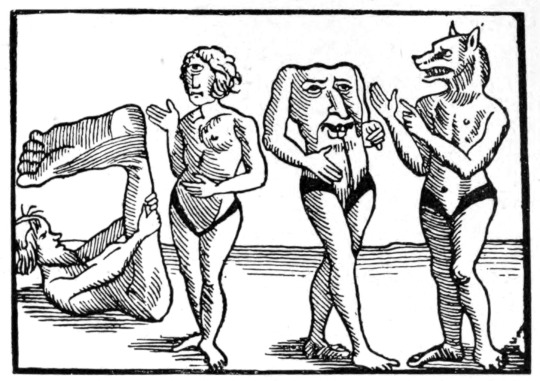
Bestiaries also got pretty wild with the creatures depicted therein, many of which were also mentioned in classical sources (such as the Herodotus quote earlier in this post). The image above is from between 1357 and 1371, in a work called The Voyage and Travels of Sir John Mandeville, or simply Mandeville's Travels, the memoirs of a man who traveled across the Middle East, India, and even as far as China. Medieval bestiaries also recorded all the same creatures shown here: a monopod or sciapod, a cyclops, a blemmy, and a cynocephalus, each different civilizations of beings said to dwell across the world (and often cited in multiple sources over considerable spans of time, which generally cite the same or similar regions for each civilization, which I've always found very interesting).
Mentions of the cynocephali span across centuries, such as in works by scribe Paul the Deacon, a Benedictine monk, and they are even mentioned in the Nowell Codex, a surviving Old English work containing Beowulf (as well as a work of the life of Saint Christopher and Wonders of the East, among others). They are also acknowledged in the works of multiple noteworthy explorers, including but not limited to Marco Polo, Christopher Columbus, Giovanni da Pian del Carpine, Ibn Battuta, and Piri Reis.
With that, I think that's a decent overview! Hope you enjoyed the post.
And stay tuned for news and updates on a major [werewolf/fantasy/adventure/horror/epic] book release later this year!
If you like my blog, be sure to follow me here and elsewhere for much more folklore and fiction, including books, especially on werewolves! You can also sign up for my free newsletter for monthly werewolf/vampire/folklore facts, a free story, book previews, and my other sundry projects and works, such as plushes.
Free Newsletter - maverickwerewolf.com (personal site + book shop + free fiction) — Patreon — Wulfgard — Werewolf Fact Masterlist — X — Vampire Fact Masterlist — Amazon Author page
#folklore#mythology#dog-headed men#dog heads#cynocephalus#cynocephali#dog man#fantasy creature#folklore fact#folklore thursday#myth#history#fantasy#werewolf#werewolves#not actually werewolves but people mix them up a lot#a werewolf has to shapeshift to be a werewolf#also these are dog-headed men not wolf-headed men#but anyway#research
70 notes
·
View notes
Text
Dunes & Waters, part 31
PART 1 • PREVIOUS PART • NEXT PART
“Four rites, then,” Sirius says from his spot at the kitchen table, Ziggy in his spot on Sirius’ lap. “Stars, that’d be Bestia, moon for Khonsu, death and body for Anubis and Wepwawet.
Remus is tucked in on the sofa, cup of tea with Effie Potter’s tricks in hands and a soft, thin blanket he’s sure they don’t own thrown over himself. He thinks to ask where Sirius got it from, which of their soft furnishings had been sacrificed to his comfort, but the gesture was too lovely and he’s greedy for more, would hate to say anything to make him stop. Sirius still seems off, since the conversation at the library, and Remus wants to wipe the slate clean, fix whatever got broken. Not arguing about a blanket seems as good a start as any.
There are a lot of things he isn’t arguing about this morning. Not going into the library office and instead working from their apartment. Eating an actual breakfast and not just having a cup of tea. Napping on the sofa instead of doing his part of the research, only answering Sirius’ sporadic questions.
Eventually, the cat comes to snuggle into his lap, kneads its little paws into the blanket. It feels like such a special thing Remus almost chokes. He’s always more emotional, the day of the full moon.
It’s as good an excuse as any, for the way he can’t seem to stop smiling whenever Sirius does something to take care of him.
Remus should have known it was premeditated, when Sirius requested they bring the notes and books back to the hotel with them.
“I have the Wepwawet and Anubis ones ready,” Remus tells him, “I mean, at least the Wepwawet one? It worked the last time.” They are the words Remus has been losing himself in the more he loses himself in Sirius.
(Let me press your mouth to your bones for you.
It is your lip that makes for you, it is the knowledge of your mouth.)
“Khonsu should be easy. He’s been worshipped since the First Intermediate Period, that’s something like six thousand years of constant prayers.”
“I think we should try the Coffin Texts first for him,” Remus agrees, “or the Pyramid Texts, he’s mentioned there too. Only briefly, but… it’s the oldest piece of Egyptian writing. That kind of thing has to bring power with it.”
“It’s the funerary text as well, isn’t it? Fits the theme.”
Even thousands of years ago, the theme for lycanthropic research was death.
“Just Bestia left, then,” Sirius taps a pencil on his stack of notes, “I’ll look into it while you’re away.”
Remus doesn’t want to leave. He’s comfortably warm, with a sleeping cat cuddled into him and a beautiful man bringing him food. Nobody would want to leave this, not for anything, but for Remus this comfort is almost mocking when he juxtaposes it against the evening he’s fast approaching. He ignores it, amuses himself instead with imagining that the next time Sirius walks by him, he’ll grab him, bring him down to the sofa, fold him into and under himself. Thinks of how pretty the noises he’d get out of him would be.
It’s an infringement, thinking like this, when Sirius is right there and being kind, thoughtful. Remus is vile for it. Feels pathetic for it. But Sirius’ shirt shows off his wrists and they’re pale and lovely and Remus thinks let me pin them down, let me taste the skin, open your mouth for me, let me fill it, let me know it.
Sirius brings him a pain potion to settle his joints. Remus doesn’t grab him, doesn’t do anything but smile and thank him. When the potion starts to work he dreams it, instead.
***
He’s gone for two days only, this time. The wolf is kind to him. Remus remembers pacing the cell, wailing in the direction where the moon would be, if the cell had windows. Curling tight into a ball instead of gnawing at own bones. Searching for smell of dog. Missing. Missing.
NEXT PART
@tealeavesandtrash
@moon-girl88
@hoje--aqui
@cocoabutterandbooks
@onion-sliced-apples
@prancingpony42
@digital-kam
@remoonysiriusly
@sweetstarryskies
@a-sunset-outside-my-window
@procrastinatingstuff
@annaliza999
@arasael
(let me know if you do/don’t want to be tagged!)
#wolfstar#remus lupin#sirius black#marauders#fanfic#dead gay wizards#remus x sirius#marauders era#dunes and waters
48 notes
·
View notes
Text

Wepwawet is an Egyptian god associated with war, protection, and the hunt. The name Wepwawet means "Opener of the Ways," and many consider him a god of possibilities. Wepwawet was originally a god of Upper Egypt, but was eventually honored throughout the country. He had a particular center of worship in the city of Lycopolis (Asyut).
Wepwawet is depicted here as a man with the head of a jackal. He carries a spear in one hand and the ankh, a symbol of life, in the other. Wepwawet may also be depicted in the full form of a jackal.
Wepwawet, opener of ways, granter of choices, unfolder of options, I praise and honor you.
12 notes
·
View notes
Text
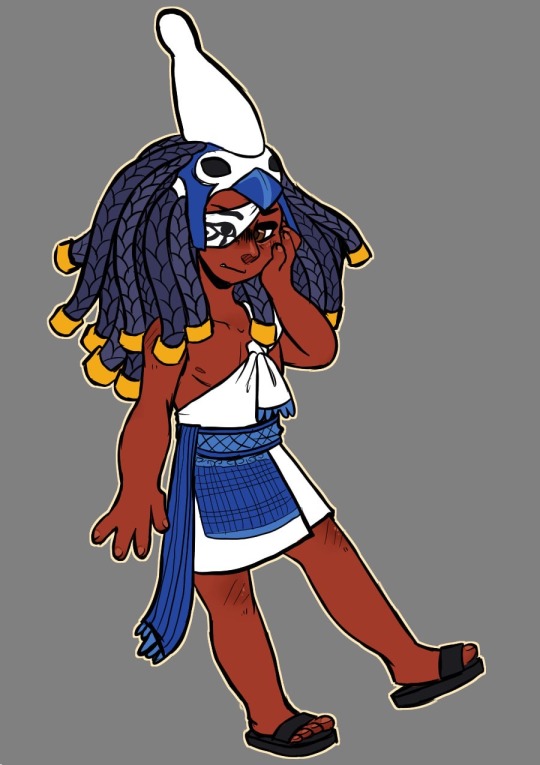

Hor the Elder and Setesh the Elder
Pre-Dynastic deity brothers who fuckin’ hate each other but live together in a Libyan oasis temple anyway, because obviously that’s how you solve your familial problems. Exposure. Or whatever.
In the timeline of Pantheon, their story begins in the pre-dynastic period prior to the unification of Kemet. Hor and Setesh, both royal princes who rule in Nekhen and Naqada respectively, got along fine with each other (aside from general sibling rivalry) until the abrupt death of their father, Andjety, the god of kingship, who drowned in the Nile. His body was not recovered.
Shit hit the fan.
See, there were two problems: first, the brothers encountered their first experience with true death. Not the kind where you go take a visit to the underworld and reunite your ba with your ka, but True Oblivion that comes from dying and leaving behind an unrecoverable body. Without the body preserved, there can be no resurrection.
The second issue? Andjety also didn’t leave a will for his kingdom. Lack of writing systems and all back in those days. So Hor and Setesh, shattered by the loss of their father, both sank into their grief, and both felt obligated to step into their father’s sandals and become the new king.
This resulted in constant warfare between the two Upper Egyptian city-states as their patron gods struggled to handle their loss. In the process, they crushed the kingdom of Abdju between them, sending its gods—Khenti-Amentiu, Anpu, Wepwawet, and Wepiu—fleeing north, where they allied with the Delta gods: Ptah, Sokar, Kherty, and Neith.
Hor and Setesh set aside their differences and united against the common threat. The two, reconciled, steamrolled the Delta resistance. Khenti-Amentiu and sons fled to the underworld through Saqqara, displacing Sokar and Kherty’s family in an attempt to avoid getting killed by the enraged brothers.
But after their victory, Hor turned against Setesh and banished him to a Libyan oasis. He wanted to be the one and only king, and even the mortal kings loved and took on his name. Sure, Peribsen tried recalling Setesh, but Hor chased him away again.
Which worked great, until a new threat arrived. He called himself Ra, and Hor was no match for him. He begged Setesh to help. Setesh told him to go fuck himself. Ra took over the lands by the 3rd Dynasty and banished Hor to Libya as well, laying the foundation for his ironclad rule.
The age of the sun had arrived.
Commissioned work, illustrated by Eaglidots
#bronzegods#bronze gods#pantheon#kemet pantheon#egyptian mythology#the two brothers#hor#setesh#predynastic egypt#ra#ptah#sokar#kherty#khentiamentiu#wepwawet#wepiu#andjety#neith#lore#egyptian-mythology#iconography
12 notes
·
View notes
Text
Still around, just plugging away at the second part of the epithets project for Wepwawet. To those ends, does anyone here happen to have access to:
Franke, D., Egyptian Stelae in the British Museum from the 13th-17th Dynasties.
If a PDF of the volume is not available but someone has access to a hardcopy, I am in need of the pages covering EA506, which should be pp.169-173, pl. 42-46.
@dwellerinthelibrary , is this something you can get a hold of?
Still in need of another buyer or two for Wepwawet jackal casts to go forward. And friendly reminder that I do custom cartouches and take commissions for ancient Egyptian & Kemetic designs should I not already have something in particular in my Shapeways shop: On the Temple Steps
20 notes
·
View notes
Text
The Importance of Worshiping Egyptian Gods and Goddesses in the Modern World
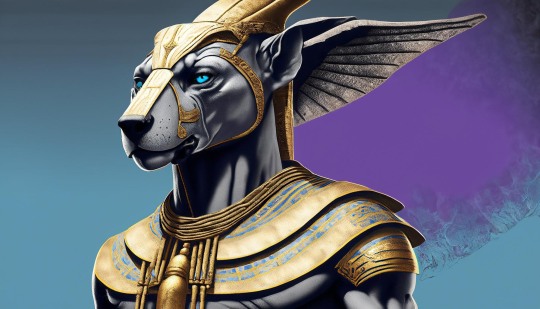
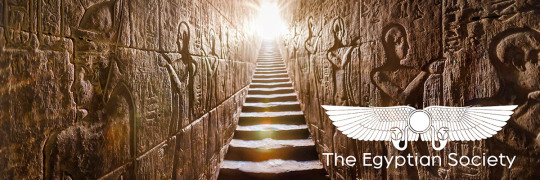




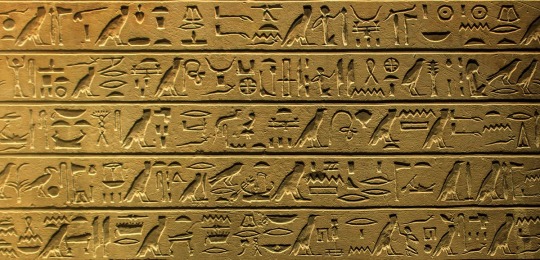


The Importance of Worshiping Egyptian Gods and Goddesses in the Modern World
The Egyptian Society: Anubis ‘God of the Afterlife’- Oracle: Andrew Rogers
“Hello my name is Anubis I look after the dead and all funerary practices when you die you travel to me and have judgement on your life this is important, it is important that you lead a good life so when you are judged upon death you transcend to the afterlife, in ancient times I was worshipped quite widely and there was much to do people feared me, in the modern times things are different after Egypt was taken over by its enemies then the process noted in the Book of the Dead was ceased, new religions came to the force and a lot of history was lost, but I still undertake my responsibilities each day. I am interested in the modern people who worship the Egyptian Gods and Goddesses and are aware of the Book of Dead, it is extremely important that we have the modern person worshipping and learning about the Egyptian Gods and Goddesses, be careful in life and be love, practice daily and we will meet when you journey to the location of your afterlife” Anubis ‘God of the Afterlife’
Anubis, the God of the Afterlife, continues to fulfill his sacred responsibilities, even in these modern times. Although the worship of ancient Egyptian deities has diminished over the centuries, there are still individuals who honor and study the teachings of the Egyptian Gods and Goddesses.
While Egypt has faced various challenges throughout its history, including foreign invasions and the rise of new religions, Anubis remains steadfast in his role as the overseer of the dead. The ancient practice of judgment after death, as described in the Book of the Dead, may have faded away, but the significance of leading a virtuous life remains paramount.
Anubis seeks to connect with those who are familiar with the knowledge preserved in the Book of the Dead. Their understanding of the Egyptian pantheon and their dedication to learning about the ancient ways is crucial. By embracing love and practicing daily, these modern followers ensure a future meeting with Anubis when they embark on their journey to the afterlife.
Let us remember Anubis, the guardian of the dead, and appreciate the importance of spirituality in our lives. May we all strive to live virtuously and be mindful of the ancient wisdom that Anubis embodies.
Anubis ‘God of the Afterlife’
Anubis, the jackal-headed god of ancient Egypt, has fascinated people for centuries with his mysterious role as the guide of souls into the afterlife. From the First Dynasty to the Middle Kingdom, Anubis played an important role in Egyptian society as the god of embalming, weighing of the heart, and ushering of souls into the realm of the dead. Despite being one of the most ancient and frequently depicted gods in the pantheon, Anubis played almost no role in Egyptian myths. However, his significance was far-reaching, as he represented the power of death and rebirth, and his black color symbolized the discoloration of the corpse after embalming as well as rebirth. Anubis was often associated with Wepwawet, another god portrayed with a dog's head or in canine form, but with grey or white fur. Together, the two figures were believed to have guided and protected the deceased on their journey to the afterlife. Anubis also had a female counterpart, Anput, and a daughter, Kebechet, who was the serpent goddess of purification. The myths and legends surrounding Anubis may have faded over time, but his enduring presence in Egyptian culture is a testament to his importance and influence on ancient beliefs and practices.
Anubis' image can be seen in various ancient Egyptian art forms, including reliefs, sculptures, and paintings. His iconic canine head, black fur, and slender body make him instantly recognizable. Anubis was an integral part of Egyptian funerary rituals, and his presence ensured that the dead received proper burial and were guided to the afterlife. Despite not having a significant presence in Egyptian mythology, Anubis remains one of the most iconic and recognizable figures from ancient Egyptian culture. Today, his image is often used in popular culture, from movies to video games and even tattoos. It just goes to show the enduring legacy of ancient Egyptian beliefs and practices, and the lasting impact they have had on the world.
The Egyptian Society
Andrew Rogers: Founder, Egyptian Auteur, Creative Director, Writer, Oracle
All images, text, design, and art license owner Andrew Rogers©.
#ai#andrewrogers#auteur#destroyer#egypt#egyptian#egyptianauteur#godofdeserts#godofthesun#instruction#Anubis#AnubisGodOfAfterlife#EgyptianBeliefs#KemetianSociety#BookOfTheDead#OracleWisdom#EgyptianAuteur#MotivationFromAncientEgypt#InspirationFromAnubis#QuoteFromAndrewRogers#LeadAGoodLife#Egypt#Egyptian#Ra#Sekhmet#Set#AndrewRogers#TheEgyptianSociety#Motivation#Instruction
15 notes
·
View notes
Note
(Sorry if you get this ask 2 times, my device is lagging pretty badly..)
It is sometimes said, about another god, Wepwawet, that his father is Seth. But Wepwawet isn’t even present in Ennead, (yet?). Some are saying this is because he will appear, to be Seth and Horus’s child. May I ask what you think of and or believe in this theory, and if you don’t, what you think of why Wepwawet isn’t present?
I only saw one ask so you're fine <3
The answers to this that I can share are complicated, and I am not a historian, theologian, Egyptologist, or mythology expert, particularly with Wepwawet, nor am I a member of Kemetism (the religion that worships the Egyptian gods), but I shall do my best. I also only joined the fandom in late 2021, and ENNEAD began around 2017/maybe a little earlier, and Mojito seemingly deleted most of her online presence (including the original site the comic was on and most of her public social media stuff) prior to my joining the fandom, so my knowledge of fandom history prior to my joining it is based on what I've dug up and asked other fans from that time. So just take what I write with many, many, many grains of salt.
The mythology
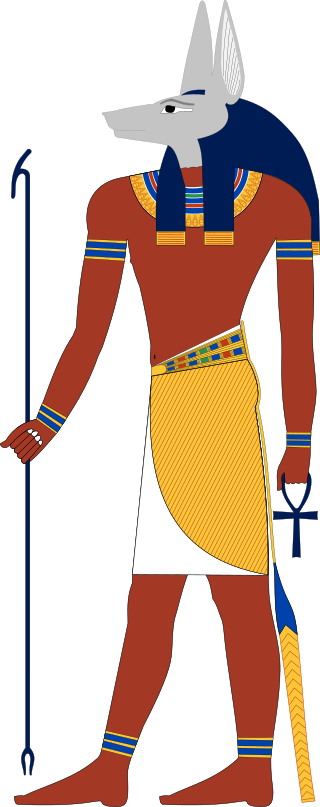
I'm not sure where you're looking, but a lot of people in fandom rely on Wikipedia, which lists Seth and Nephthys as Wepwawet's parents. I don't know where Wikipedia got that from, other than, at least in some instances in the mythology, Wepwawet is claimed to be a child of Nephthys (not with Seth, purely Nephthys alone), and Nephthys was sometimes married to Seth (so people assume that Nephthys had a child with her husband, Seth, which, as we know, is not true in ENNEAD in re: Anubis). I read one of the articles the Wikipedia page cites, which is Wepwawet in Context: A Reconsideration of the Jackal Deity and Its Role in the Spatial Organization of the North Abydos Landscape from Journal of the American Research Center in Egypt (2007) by Mary-Ann Pouls Wegner, which, to my recollection, doesn't mention his parentage at all, or at least doesn't mention Seth (but if you make a free account on JSTOR, you can read the article in full for free and see yourself, I would highly recommend it, it's a neat article).
From a general search elsewhere, there's no clear indication of who his parents are. Jenny Hill's page on Wepwawet doesn't mention Sutekh/Set/Seth at all in the article, though she notes that Wepwawet's origin and family changed over time as belief systems changed and merged, like all the gods, as groups of people came together through marriage, trade, war, etc. He has apparently been noted at times as the father and/or brother of Anpu/Anubis, the son of Osiris and Nephthys, the son of Isis, sometimes even with connections to Horus... It just depends. He's also sometimes viewed as a sort of parallel to Anubis and Osiris (The Complete Gods and Goddesses of Ancient Egypt by Richard H. Wilkinson (2003) 191-2). Since Anubis is sometimes viewed as a child of Seth, so too is Wepwawet (though as we know in ENNEAD, being Anubis' brother doesn't de facto make you Seth's child, as Anubis and Horus are half-brothers through their father Osiris, and both are Seth's biological nephews, not his biological sons). He's also sometimes connected to Ra.
In sum: there really isn't anything I can find, from a historical and mythological standpoint, about Wepwawet specifically being Seth's child in mythology (other than by association with Nephthys and/or Anubis), let alone Horus' child and/or Horus' child with Seth. This is not particularly relevant for fanworks or fan theories or ENNEAD, all of which can do whatever they want, but that's what I found.
The fandom perception
One thing to know about this fandom is that mpreg is popular in it, as are child OCs (and, to a degree, omegaverse, but not all omegaverse has mpreg and not all mpreg is omegaverse, nor did omegaverse originate the concept of mpreg). Many folks in the fandom latch onto any character, particularly actual gods they can find who might somehow be Seth's child so they can have Seth have more children/actual biological children (particularly children who are gods). Any commentary from fans that Wepwawet will appear in the manhwa, possibly because he hasn't yet, is honestly baseless speculation and wishful thinking and or them talking about their own fanworks without making it clear. I don't think he's ever been mentioned anywhere in the manhwa, and so far as I am aware, Mojito has never commented on it. If Mojito has mentioned Wepwawet somewhere, particularly in context of his showing up in the manhwa, either I've just not seen it or it has otherwise been lost to her mass deletion of most of her public social media presence outside her twitter account some years ago.
Wepwawet is popular in fandom I think because:
Anubis is popular and Wepwawet is often associated with him
The idea of Anubis having a brother with similar abilities is popular, especially if Wepwawet is a rival/otherwise makes Anubis jealous/can work as a teacher
The idea of Anubis having a brother, older or younger, is popular, or even possibly being a twin
People like dogs
People like how it's sort of a black-and-white thing because Wepwawet has a sort of opposite color scheme to Anubis (to differentiate them in art)
People just like Wepwawet as a mythological figure, some also worship him
There are just a lot of reasons this character in particular is popular in fandom, particularly as a child OC for fanworks. Generally, though, he's not the most popular fan child (that's usually the Four Sons of Horus or fully made-up characters, though I admit I don't really keep track of it).
I have seen no indication that Mojito plans to have Seth and Horus be parents of anyone (other than Seth being Anubis' father, and maybe a cat dad; he's friendly with the three human children he's met, but there's a difference between being a protector god/being friendly with children, and being a father). Horuseth being parents, either through adoption or mpreg, is popular in fanworks, often due to folks liking/knowing of The Contendings of Horus and Seth, which is from 1147 BCE, and features a story of Horus and Seth fighting, wherein Seth eats Horus' semen and later during a trial, Thoth (in some versions) is born (often from Seth's forehead). ENNEAD!Osiris preparing to impregnate Seth by feeding him the power of creation (which Osiris did not actually accomplish because he was interrupted by his own lust and Seth in S01E42, and then he used the power on himself in S01E48), has only encouraged a chunk of fandom's desire for mpreg. That both the mythological Seth and Horus, depending on the story, have a variety of kids to pick from (but usually not with each other, outside maybe Thoth) only helps.
Allegedly, Mojito said there would be no more about mpreg in the manhwa than what Osiris attempted, though I'm not sure where she said it, under what context, or what she specifically said. Mojito's alleged words here are from fandom repetition (what people in fandom have told me, and I believe what they were told by other people; the Discord I first learned this in is locked and was dying when I left it some years ago). What we do know is that the universe has a built-in rule that male gods cannot create children, only female gods can, because only female gods have the power of creation (S01E48, S01E70, S02E78). As Osiris is the god of life, and even he couldn't get around this rule without trading Nephthys for her power of creation, I don't know how exactly Horus would get around it in canon (heck, we honestly don't even know if Osiris' plan would have been successful, given he failed a lot (S02E78)). In my own mpreg fanfic with Horuseth, I just messed around with it because Horus is a sun god (like Ra) and so Just That Special and Seth is a shapeshifter, and Horus got messed around with the magic mirror, which has (in the fanfic), Hathor's magic on it. (and Wepwawet is not in that story, Horuseth's child is someone else). But I don't honestly believe that or anything similar to it will happen in canon. Otherwise, I just did the one eggpreg story by doing a Venom crossover, which doesn't rely on the rules of ENNEAD, as Seth is human and Horus is an alien parasite.
But regardless of what Mojito said, that doesn't stop the fact that mpreg is at least presented as a possibility in the story, and that encourages folks to wish for more, especially as it's been years and maybe her opinions on the matter changed.
In sum: there is no evidence Mojito will add Wepwawet in any capacity to the manhwa, let alone as a child of Horuseth, or Seth alone, and little to none she will add in mpreg or make Horuseth parents. Wepwawet as an OC of sorts in varying capacities is a relatively popular fan conceit, though.
My thoughts on the theories/fanworks
Folks are free to imagine whatever they want for headcanons! Folks have fun making child OCs and writing mpreg stories, and I wish them the best of luck (I had fun with my own mpreg and eggpreg stories, though I don't have more planned). This particular fan idea of Wepwawet as either the child of Seth and/or the child of Horuseth is, unfortunately, not my cup of tea. It also has no basis in canon, very little if any in the mythology I'm aware of, and Mojito has not hinted at it being a thing, now or ever, so I think it is extremely unlikely to happen in canon. I also honestly hope it doesn't happen in canon, purely because Horuseth having babies/children outside my brief time with the idea in the fanfic I wrote (mostly as a writing challenge) is not something I'm into, but if Mojito writes it, I'm sure it'll be interesting.
For folks who love it, though, there are a number of people who are into it, so that's awesome for folks who like it and want fanworks of it!
I actually think Wepwawet sort of gets referenced in See You My King, an unrelated boys love manhua by Wen Yuan that sometimes uses Egyptian mythology as a base, as Mohemisi (who has dark hair) is very aligned with Anubis (and Horus), and he has an older brother, Hattsutter, who has white hair, so it's possible Wen Yuan is using the story of Anubis and Wepwawet as brothers.
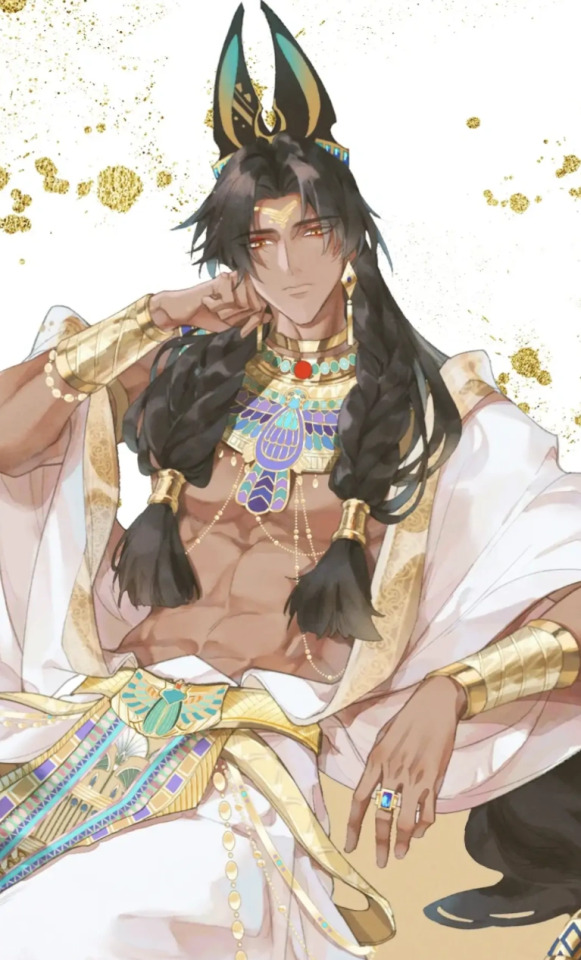
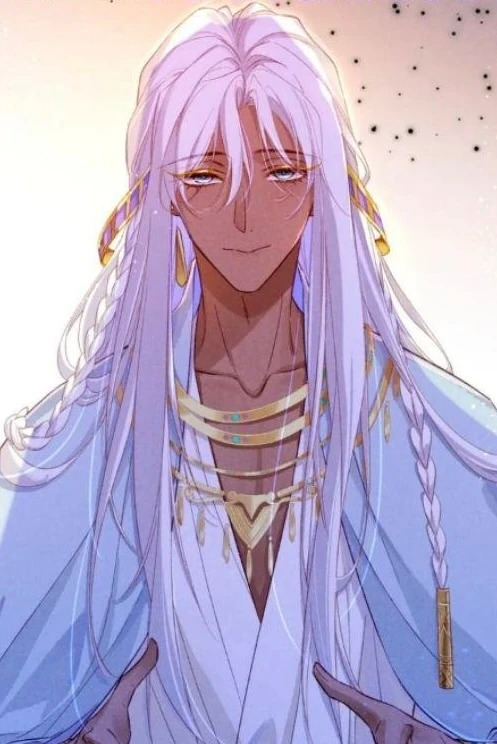
Hattsutter was also reborn as "Anubis" (with the help of a human clearly masquerading as Seth), who is made out of white energy. But SYMK focuses on different mythology (when it does so at all), and Anubis is much more central to the narrative as Mohemisi is one of the leads and the sole love interest for the protagonist, whereas Anubis in ENNEAD is a side character and non-principal love interest of the story protagonist. But if people want Wepwawet stuff... well, it's sort of there, I suppose?
Why I think Wepwawet is not present in the manhwa
The simple answers: Wepwawet is not present in the manhwa because Egyptian history and mythology is huge and Mojito cannot include everything as that is literally impossible, and the story is also not about him so it's less likely he'll show up.
We as humans struggle to comprehend just how long Egypt has existed in some form. It is thousands of years old (there's a viral post floating around tumblr somewhere about how ancient it is). It has a great number of gods and immortal beings in its culture and mythology and many, many stories about them, many of which we only have fragments of, but we sure do have a lot of them. It is quite literally impossible for one manhwa to focus on all of them, particularly when the manhwa is focusing on Horus and Seth, not every god in existence. Mojito is writing a boys love comic, not a history of Egyptian mythology. Hamish Steele actually did a robust job in trying to cobble together a graphic novel that covered a great deal of the known myths in all their often conflicting glory (again, different gods were worshiped different ways over time: e.g., Horus and Seth have been brothers and uncle/nephew and completely unrelated; also there are many falcon gods named Horus). And even Steele couldn't cover everything (I don't think Wepwawet is in there, either), and he accomplished his work mostly through humor and not focusing overmuch on any particular character (though much time is given to Seth, Isis, and Horus), whereas ENNEAD is more focused on drama (albeit with humorous moments). So again: Wepwawet is likely not in ENNEAD because Mojito cannot cover everything, and the number of things she has chosen to cover simply does not include him, at least not yet. That doesn't mean she won't, but it doesn't mean she will, either. He's not the only Egyptian immortal being who hasn't shown up in some form.
Wepwawet is also likely not in the story because the story is not about him. He is not closely connected to Horuseth, he is connected to, if anyone, Anubis, and sometimes Nephthys and Osiris. If he shows up, it will likely be as a shadow figure or side character with no lines, as a number of other gods have seemingly showed up, like in S01E20 and a few other places:

(The assumption is this is showing gods like Serket, Ptah, Sebek, Seshat, Min or Amun, Anukhet, and some other gods surrounding Isis in the middle)
It's a way for Mojito to incorporate more mythology without dedicating a ton of story time to it, and keeping the focus on the central cast. Though considering the similarities in their silhouettes, he'd probably just show, if he does at all, as a side character in color, so the audience can tell it's not Anubis.
If there is a trip to Duat, I think Wepwawet may show up in some form. He may not. Who knows! He could show up as a mentor for Anubis, an ally in Duat, or something else. He also might not show up at all because two jackal gods is kind of confusing, and he could overshadow Anubis. We already have a prevalence of cat gods (e.g., Tefnut, Sekhmet, Bastet). But that Mojito is willing to include similar gods does show she'd potentially be willing to show other gods similar to Anubis.
That was long, but that's all my thoughts on that. Thank you for asking <3
#fallfasks#ennead#wepwawet#mpreg#not gonna touch on how too many folks assume everyone in the fandom is into mpreg#when like um no#as someone who is into mpreg and will likely write it again elsewhere I enjoy it in specific circumstances#not all of them#that's not to lambast folks who are into it more than I am#I just have never seen the way some fans treat it in all my years of dealing with fanbabies in fandoms not dedicated to pregnancy#it's very strange#think it'd be less of an issue if the fandom weren't so small#but alas#and tbh the unexpected was partially written so folks would stop bugging me to write horuseth mpreg#it was a fun fic#I just have complex feelings about it#fallfthoughts
2 notes
·
View notes
Text
Gonna spitball stupid ideas about God of War since I just finished GOW: Ragnorak.
Putting under a readmore so I don’t kill anyone with a potential huge block of words-
Also spoilers, obviously.
So onto the first-
Who will the next game follow?
Ngl I feel like the obvious answer is that it follows Atreus. He’s going on a journey to find other Giants. It makes sense to follow him.
This game feels like the perfect conclusion to Kratos and his story. Him leading the Nine Realms and fixing the harm done to it (or as much as he, Freya and Mimir can). I think it’d do more harm then good to force him into another game.
Could he cameo in a game solely with Atreus? Maybe? I think a cameo of him would always be a bonus. Whether it’s just dialogue or if him and Atreus find a magical way to communicate long distance.
Actually maybe no magical communication, so then the possible reunion would be so much more sweet. And they better reunite.
Where will the next game take place?
In my heart- Egypt. Egypt was the original idea for the 2018 game, and it was eventually swapped to Norse mythology.
Which fun fact- Atreus wasn’t originally Loki! It was conceived halfway through, and honestly props to that guy who suggested it. But if we’d kept with the Egyptian route I think our boy would’ve been just normal boy.
But also the reason why I say Egypt- Egyptian hieroglyphs are one of the three languages on the Mask of Creation. The others being Ancient Greece and Japanese.
Now along with it being the original setting and cast, we’ve also had many artifacts that originate from the Egyptian mythology.
Such as an Ankh in GOW: Ragnorak, and Atreus himself even puts on a helmet that originates from the region (if I am remembering correctly) in 2018.
And along with this, I can see Atreus having a time in the Egyptian Pantheon- most of them do have animal forms that they can also slip into, which would give Atreus more of an in I guess.
Also the concept art have the Egyptian Gods seen as gigantic (other then Thoth in that one comic, though maybe he could also become big). So I think he’d logically head that way eventually.
Here is some concept art just to share them
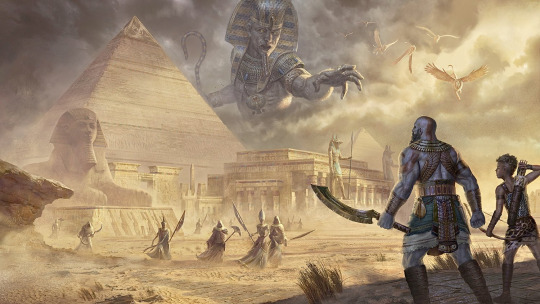
Giant God in the distance (maybe Ra, or even another one such as Osiris/Set/Horus)
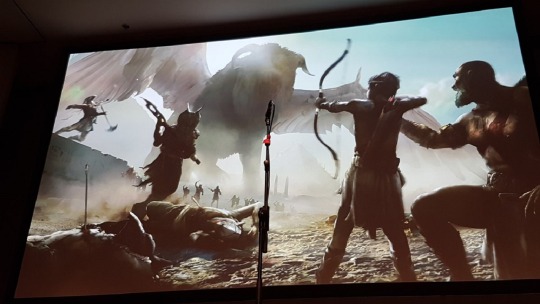
Killing giant Sphinx from the looks of it
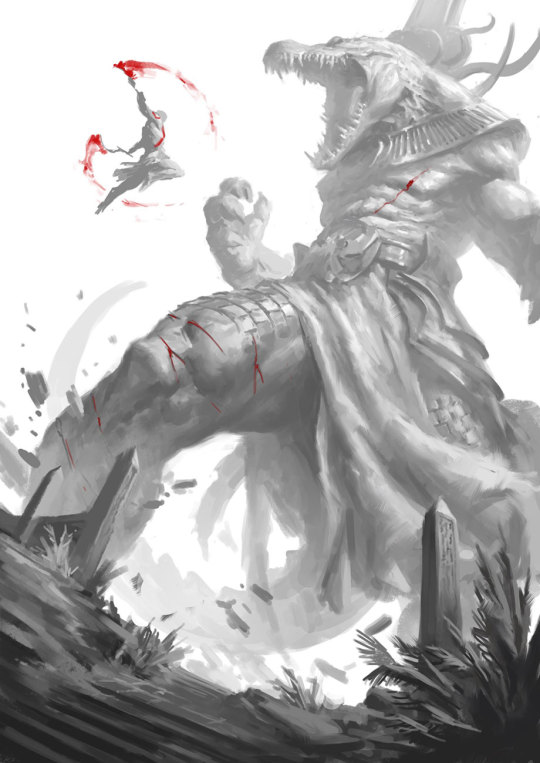
Finally not 100 certain on this piece, but Kratos fighting a giant Sobek
Who would Atreus be in the Egyptian Pantheon?
Now this is a tricky one. Mostly because it’s one you gotta do carefully.
Atreus being Loki is the twist. And it works solely because he was a new character. Kratos works as Fárbauti because he isn’t super prevalent in the mythology. He’s only mentioned by name.
Thus Atreus should he be also someone in the Egyptian Pantheon (whether outright said or stupidly highly suggested)- he can’t be a big player in the myths. We know the boy now, and forcing him into the role of Set (a similar Chaos being), who is a big player doesn’t work. Because we know both their stories, and we know they don’t fit.
Therefor a suggestion would be to look at deities not super well known in public eye, or even those that don’t have as many mythological stories of them.
My suggestion? Wepwawet. There isn’t too much known of him, but also Atreus could fit him.
Wepwawet is known to have two known weapons- a mace and a bow. He is a wolf deity (a form well associated with boy), and also said to accompany the Pharaohs on hunts. And he is the “opener of ways” which Atreus like his father can bring. Especially if he continues the fight against fate like his father.
But he’s a War God, I hear you say. And I say- so what? Yes, Loki isn’t a war god, but Atreus is also Y’know Atreus. And he was raised by Kratos of all people. I can imagine he could theoretically take up the God of War mantle. Which I’d imagine they’d have to if they want to continue calling the franchise following Atreus, God of War. And he could be a Tyr type and fight for peace.
But he doesn’t have to claim the role of any God or mythological figure tbh. But if they have to make him someone I think Wepwawet would be the best bet at the current moment.
Sigyn?
Not sure what to make the “title” of this section, but this is mostly a small ramble-
I’ve seen some nitpicks or complaints that Sigyn wasn’t seen in Ragnorak and I understand for the most part.
I think Atreus didn’t have enough time in Asgard to get to know too many people. There’s many other Asgardians we never met. But we did meet the big players (or the ones widely known by media).
But with the changed fate shenanigans, this likely prevented Atreus from meeting Sigyn as well.
However I do think we could still meet her.
As we saw from the end, many pieces of Asgard fell into the realms. Who’s to say she also didn’t fall with these pieces and managed to, I don’t know? Wonder off?
It’s possible she’d even possibly travel into another place entirely in trying to escape what was happening. After all, how many of the Asgardians were told of what Odin had done? How many did Sif get to inform about the change in plans before the collapse?
So, if she isn’t in Vanaheim, wasn’t updated, and did fall with the pieces of Asgard, why wouldn’t she run? Asgard fell to the enemies and they could be going after every Aesir God. And who knows? Maybe she managed to get to another area entirely far from the Norse Pantheon.
Could do enemies-to-friends-to-lovers arc with her and Atreus even. And yes, Atreus can have multiple loves in his life. Whether it leads to a polyamorous relationship or just a period of romance (between him and Sigyn or Angrboda idk) I’m not sure of. But I think I’d be fine with either.
And her parents can just be two unnamed Aesir Gods. They could imply her parents to be someone sure, but it also fits to just have them being unnamed similar to Angrboda.
But I for sure feel like they have a chance to still include her.
Edit to this 2/11/24: since posting this I am very much more of the supporter of Atreus and Angrboda. I’m still in that mindset of one of them can very much have different romances because love to me is fluid, and who you’re with can change depending on time and place.
So yeah 🤷 I still think she(Sigyn) can still be included somehow one day as a potential love interest. Or polyam relationship, but that’s just me imagining the impossible (probably won’t see a polyam relationship done good in a loooooong time lol).
But if it doesn’t happen it doesn’t happen. But if it did happen I wouldn’t be bothered too much since that’s life. And we know that Atreus and Angrboda end up together in the end, we just don’t know the journey to that point. Which what that journey entails could be anything.
Now who would be the big bad?
If it’s Egypt, it’s Ra.
Now there’s many Gods that are the Pharaohs (such as Osiris, Set, and Horus to name a few), but Ra is the big player. Pharaohs claimed to the be the sons of him, and other gods would often times merge with him.
This could be the combined form of Ra, known as Amun-Ra even. Since in this form he is considered the King of the Gods.
But also if Ra was the big bad, that means the Eye of Ra could be bosses. Since there is a mythos of him sending the Eye of Ra as the form of Sekhmet to destroy the humans who were plotting to rebel against him.
And if Atreus was believed to be a threat why wouldn’t one of Eye of Ra be sent after him? And there’s at least three (Sekhmet, Hathor and Bastet).
Last thing too is that Ra sometimes has a myth attached to him where he is reborn everyday. With the sunrise he’d be born again, and I think that’d be an interesting thing to see play out.
Most the final big bads have been older guys, and while Ra could fit the bill- it’d be interesting to see him at different ages. Imagine an age we could see him at even being the same age as Atreus. Maybe the final fight could be just holding him off until sunset when he’s at his oldest.
But the image of Atreus befriending someone his age and then an hour or so later running into the same guy but ancient is something that digs at my mind in a good way. Imagine the fuckery.
I kind of played with the idea in my head that the Eye of Ra Goddesses came from different pantheons. Since most of them their only parent is Ra (Bastet sometimes has a mother that is Isis), one could potentially play with it. Maybe one of them is from the fallen Greek Pantheon, one from the Japanese (the other languages on the mask), and to tie in more form Norse the final one from that Pantheon.
Hell Sigyn could even be one of them, and it would still work tbh since she’d be a new character. Maybe she’d be Bastet.
But that’s a big maybe idea. Since them being just plain ol Egyptian origins is also fine.
Calliope
Now this one is a tricky one as well- and I’ve seen mentions of people saying she’s gonna come back. And tbh? I’m not sure. I don’t think she should because then the impact of losing her (twice) wouldn’t be there.
But I feel like there can be a way since by the end of GOW3 Greece had fallen, and the underworld opened to allow those within to travel. Theoretically she along with other members of the family could’ve wondered out and away.
Personally if she came back, I can’t see Athena not snatching her and using her similar to Kratos. Buuuuut maybe she wasn’t caught by Athena?
Tbh I kind of like the idea of her becoming a God in her own right and having beef with Atreus.
Because Kratos ‘replaced’ her and her mother with a new family Y’know. Not sure what God she’d be. I kind of played with her being Sekhmet since Ra “created” his daughter with magic. Hell with that you could even have his two other daughters Hathor and Bast being individuals from other pantheons that he took in and made his daughters.
Could even do the same to Sigyn :0
But that would be a big stretch and not likely at All. Just a little playful AU in my mind tbh.
#caged rambles#god of war#god of war rambles#Atreus#sigyn gow#that’s all I’ll tag since those were the two big names#gow Ragnorak spoilers#just in case#debating making a god of war side blog to not bother friends#this has been in my drafts for months lol
18 notes
·
View notes
Note
If you put your two OCs Sabertooth and Wepwawet in a room alone... would they get along??? Become friends????
hi
Hi I'd to think so. I can imagine them talking about their lives while drinking whiskey. Sabertooth would talk about tigerclaw, the influence, what led her to be Survivalist and living in the forest. While wepwawet talks about his tribe, his mother, his sister, anubi, ramses, what led him to his life of living on earth. Sabertooth would ask wepwawet about his ability to shapeshift and what egyxos is like. And wepwawet would ask what it likes being a mutant. I can also see them joking around in egyptian (sabertooth know how to speak in egyptian). wepwawet then says sabertooth somewhat reminds him of his brother wife (anput) she was loyal, strong, a little snarky, brave.
#egyxos#my ocs#tmnt 2012#crossover#friends not ship#reply to a friend#thanks for the ask!#ask and answer
3 notes
·
View notes
Text
Werewolf Fact #69 (dude!) - Ancient Egypt
Well, I thought this month would be about something else, but my patrons spoke differently! And I always listen to my patrons when it comes to folklore facts.
So, without further ado, let’s finally get back to werewolf facts! This is a big one, as it’s a lifelong favorite topic of mine!
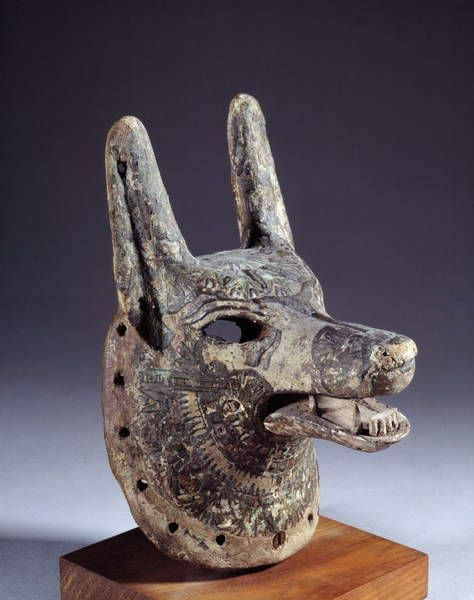
An ancient Egyptian mask worn by a priest during rites performed for the dead, who would have “taken on the aspect” of the wolf-headed god Anubis
Let me just open by saying that I absolutely love ancient Egypt. It’s fascinated me since I was a small child and I was reading a tiny children’s book about cats, and ancient Egypt was discussed. Naturally, when I found out about Anubis, I was even more interested. Then came games like Age of Mythology and many movies... especially The Mummy (1999), of course. Anyway!
Ancient Egypt didn’t have a negative opinion of wolves. In fact, several important deities had wolf heads and were associated with wolves. Let’s begin with something that’s always interested me, which is the city of Lykopolis (as it was called in Greek)...
More under the cut, since this post got so lengthy!
Lykopolis (ancient Egyptian transliteration is something like “Zawty”) was an important city located on the western bank of the Nile, capital of the Thirteenth Nome of Upper Egypt during about 3100 BC. The primary deities of the city were - as you might imagine - Anubis and Wepwawet, both wolf-headed gods. Mummified wolves (golden wolves, not jackals; more on this momentarily) have been found in various excavated chambers throughout the city ruins, of which very little still survives.
The city has a very fun story behind it, as told by Greek historian Diodorus Siculus. In the first century BC, an army of Nubians invaded from the south - but they were repelled by packs of wolves. These wolves drove the army from the southern borders of Lykopolis and then back beyond the borders of Egypt. According to Diodorus, this is why Lykopolis was called “the city of the wolf” and revered wolves and wolf-deities so greatly.
Some sources claim that these wolves were summoned by the god Osiris, who was also worshiped as a wolf in Lykopolis, and had also, at one point, taken the form of a wolf. I will admit I personally haven���t read this source, as it’s in French, so I can’t fully attest to that element of the story - I haven’t seen that one cited very often in various specifically ancient Egypt history sources. Regardless, it’s fun if true. Either way, the tale of the wolves driving back Egypt’s enemies was definitely recounted in detail in a primary historical source!
By the way, you’ll hear a lot of people refer to these deities as “jackal-headed.” It’s very popular still to call Anubis the “jackal god.” We now know, though, that the animals in question were in fact not jackals - they were indeed wolves. Scientists for a long time asserted that they for some reason knew things better than the ancient Egyptians and Greeks who actually lived during the time period and retroactively dictated that they weren’t wolf gods, they were jackal gods.
However, the Egyptian jackal was discovered to be a species of gray wolf. You can read a lot about that here in this article, regarding how people didn’t believe wolves lived in the area during those time periods, but we found out they did, and we also found out that the mummified wolves in Lykopolis were - yes - wolves, like their contemporary cultures said.
A quote from the article: “the Egyptian jackal is in fact a gray wolf. ‘We now know that wolves were indeed in Africa in the days of the ancient Egyptians—and long, long before,’ says Stenseth.”
I honestly don’t know why everyone thought wolves couldn’t have lived in the area during these time periods (when we know perfectly well a wide variety of animals inhabited regions they no longer inhabit, and that we discover new species in the deserts even to this day) or decided the ancients didn’t know what they were talking about, but anyway...
Another fun fact, by the way, is that the word “jackal” didn’t even enter the English language until the 1600s, borrowed from French, which in turn was most likely borrowed from Persian - not Egyptian. The animals in Egypt were wolves, and we now know that they were also wolves scientifically. In fact, some scientists even believe it’s possible that jackals (as in actual scientific jackals, not golden wolves) didn’t find their way into the Egyptian region until much later, when these wolf gods would have been well-established. They may have followed travelers out of Arabia. This is speculation, though, but regardless, the long-believed-to-be “jackals” of ancient Egypt were all wolves. So it sounds like we should’ve believed the ancient Egyptians and Greeks in the first place, huh?
Long story short - Lykopolis was indeed a wolf city, wolves drove invaders out of Egypt, and Anubis, Wepwawet, and Duamutef were wolf gods. Not jackals.
Please note that there are those who would argue with me that some of them are jackals and some are wolves, or that they were all jackals, or whatever else, but in my personal opinion (and the opinion of many historians and scientists), it’s very clear across depictions, mummified wolves, historical accounts from both Egyptians and Greeks, etc., that these many Egyptian wolf-related beings were what we now call “golden wolves” or “Egyptian wolves” (and sometimes referred to as “jackals” still despite their genetics), which are indeed gray wolves, and not a species of true (genetic) jackals. There also exist theories that these wolves are something that no longer exists, and also that the modern animals we have are interbred wolves and jackals. Theories abound, whatever the case.
Then of course there are those who say that Anubis was the jackal-headed god and Wepwawet was the wolf-headed god, due in no small part to inherent biases that wolves only come in “gray.” I think those are all very silly, especially as we already know that colors in ancient Egypt were highly associated with ritual and meaning, rather than directly stating that Anubis’s head was black because he’s some kind of black-backed jackal - which don’t even have black heads, anyway. We have multiple associations between Anubis and wolves, and just because Wepwawet was often depicted with a grey or white head doesn’t make him a wolf and Anubis something different. Therefore, I personally will continue to refer to all of these as wolf-headed gods, and I apologize if that bothers anyone.
Sorry. Brief Mav-rant there. More important things to follow, because we haven’t even talked about those deities yet!
So now let’s talk about these gods themselves...
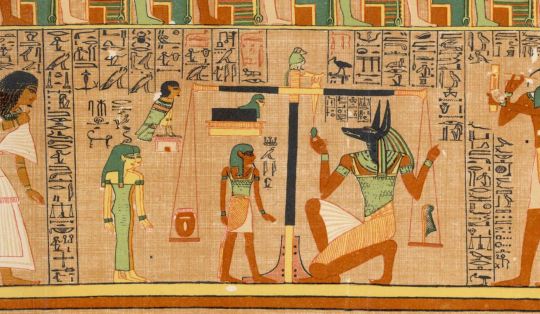
Anubis in the book of the dead (which was not actually a book)
Easily my favorite thing in all of ancient Egyptian mythology, Anubis (known by many other epithets, including but not at all limited to "Lord of the Sacred Land," "He Who is Upon his Sacred Mountain," "Master of Secrets," and "He Who is in the Place of Embalming”) is the god of the dead. He was the protector of graves, guardian of the dead, the shepherd of souls passing into the afterlife, and many more roles, including the ever-important Weighing of the Heart (as seen above), the results of which would dictate whether or not someone was allowed to enter the afterlife - or if their heart was devoured by the monster Ammit and their soul destroyed forever.
Anubis was depicted with the black head of a wolf. His head was colored black because black was the color associated with life, the life-giving soil of the Nile River, regeneration, and embalmed bodies, and he, of course, is also the god of mummification. Anubis is one of the single most important deities in all of ancient Egypt, depicted and mentioned very frequently, even more than most any other deity - however, despite this, there are almost no stories actually involving him.
But no, Anubis was not “evil,” as much of modern pop culture would have you believe! (Sorry The Mummy Returns, I love you to death, I really do - but it was super rude to make Anubis evil.)
Long story short, Anubis was freaking awesome, and there’s way too much to say about him and his awesomeness for just one post. Maybe I’ll do a separate post all about him later, because he’s a personal obsession of mine.
Anubis’s brother (at least, he is considered to be this by some) was the god Wepwawet, another wolf-headed deity. Wepwawet was a man with a white or grey head of a wolf (though some think he may have also had a black head like Anubis, but others claim that is not the cause and the coloring was on purpose as we have seen it in too many different places - still more claim it was just the artist’s preference; it’s hard to know any of these things for sure)...
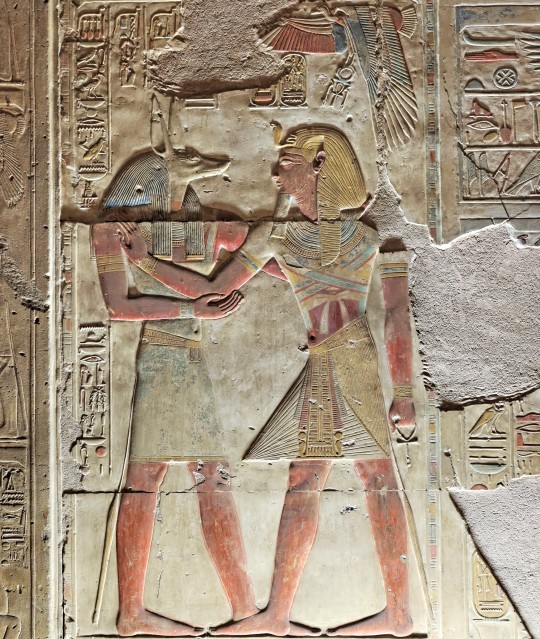
Wepwawet with Pharaoh Seti I (try not to read that in Ardeth Bay’s voice, I dare you. I don’t know why you wouldn’t want to, though)
Like basically all deities of ancient Egypt, Wepwawet is a complicated god, a deity involved in some funerary rites, but especially associated with war and royalty. Wepwawet means “opener of the ways,” and he was depicted as a man with the head of a grey or white wolf, as well as wolf at the prow of a solar boat, sometimes said to lead armies, to scout, and even to have the honor of going before the pharaoh himself. He is also known by the title “one with sharp arrows more powerful than the gods.”
A very important god, Wepwawet is one of the oldest gods of Egypt ever recorded, and he was always associated directly with royalty and specially the pharaoh. He was said to accompany the pharaoh on his hunts, as well as protecting the pharaoh in life and the afterlife - he is a symbol of divinity of rule and of kings in general. He is, for certain, a very good deity, rather than some kind of evil wolf of Western literature.
And lastly among the prominent wolf-headed deities, we have one of the four sons of Horus, Duamutef...
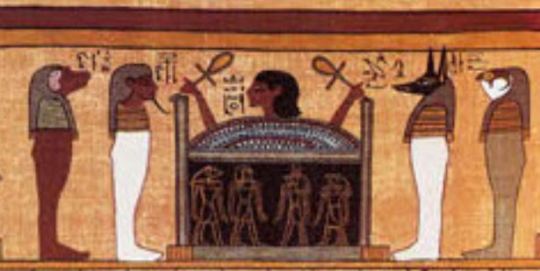
The four sons of Horus were depicted upon the canopic jars (jars containing certain organs of the mummified dead) starting in the First Intermediate Period of Egyptian history, which was around 2181-2055 BC. Each deity protected a different important organ; Duamutef, the wolf-headed god, always protected the stomach and represented the direction of the east. Please note he was not always depicted with a black head like Anubis; sometimes he also had a white or grey head. It varied. Likewise, in later periods, the forms of these various gods were sometimes mixed up, and a different son of Horus would have the wolf head. These deities were depicted not only on the canopic jars, but also on many other funerary artifacts, including the sarcophagi that would contain the jars.
So we have all these wolf-headed deities... but does any of this tie into werewolves at all?
Well, it doesn’t, really. There seems to be no indication that Anubis, Wepwawet, Duamutef, or anyone else did any particular shapeshifting, and they certainly weren’t cursed. They were gods. Anubis and Wepwawet are both sometimes depicted as simply a wolf as opposed to a wolf-headed man - as many of the Egyptian gods are depicted as their animal counterparts, including Ra, Horus, Hathor, Sobek, and many, many others - but that’s merely his animal aspect counterpart. Depictions and aspects of the gods of ancient Egypt (and also, later, how Rome and Egypt intermingled some of their deities during the Roman occupation, such as Hermanubis) are extremely in-depth topics. I’ve always loved studying them, but they are immensely complicated - certainly far too complicated for this post! So let’s get back to the matter at hand...
I’ll be honest, I have yet to find a credibly-sourced legend that talks about anything like an ancient Egyptian “werewolf.” I’m pretty darn sure they didn’t have anything remotely like what we consider among actual werewolf legends, my friends, and especially none that meet my personal criteria. The ancient Greeks, however, absolutely did, as you probably know if you’ve spent time browsing my werewolf facts masterlist (link at the bottom of this post!).
Wolf-headed gods, however - yes, they definitely had those, and no, they were not “evil gods.” In fact, some of them were very highly revered and associated directly with necessary aspects of life and death, as well as with pharaohs.
Speaking of, if you love ancient Egypt (and also adventure movies), you should absolutely check out my new novella that came out just this past June - Wulfgard: The Tomb of Ankhu!
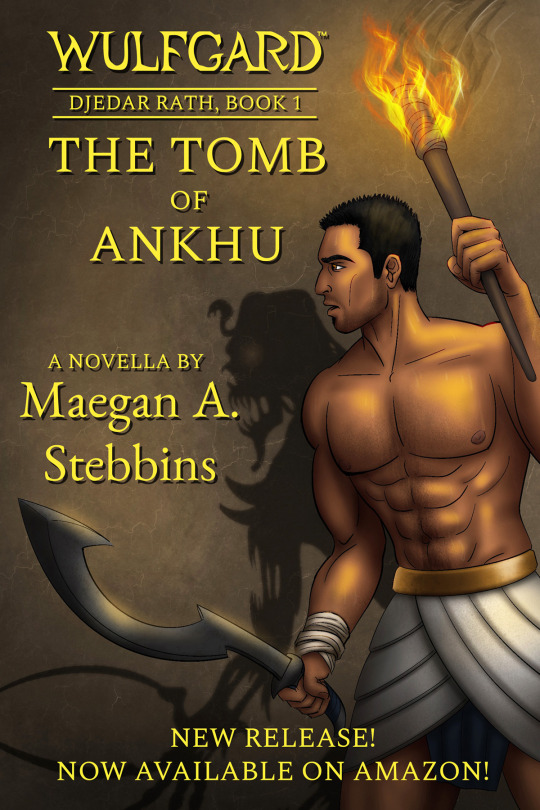
It is the first of two short novellas that tell an exciting tale about adventure, an ancient curse, mummies, memorable characters, and last but not least lots of Anubis and other legends, all of it set in the vast ancient-medieval dark age fantasy realm of Wulfgard: a world where all myths are true.
Every book release means the world to me, and this one is no different. I’m very proud of this story, and I really think you’ll enjoy it.
Deep in the southernmost deserts of Wulfgard lies the resting place of Pharaoh Ankhu the Endless, one of the greatest evils the land of Kemhet, or the world, has ever known. So terrible was his power that the gods themselves cursed him, sealing him away in an underground labyrinth. Ankhu rises with each darkening of the moon, a walking mummy, wandering this tomb in search of his own still-beating heart, without which he can never reach the afterlife.
Over untold ages, Ankhu’s tomb remained undiscovered, a secret protected always by the loyal Medjai, an order sworn to guard Kemhet from all threats. And now, a new threat has arisen: Lord Tefnahkt the Red, a powerful warlock, drives his cult and his many slaves to uncover Pharaoh Ankhu’s resting place and steal the mummy's power.
While a small group of Medjai desperately work to stop Tefnahkt’s plans, one slave may become the key to putting an end to this evil once and for all: Djedar Rath. In a race against time, Djedar must lead the Medjai to prevent Tefnahkt from opening the tomb of Ankhu before the coming of the new moon, when the undead Pharaoh will awaken once more. For, if Ankhu escapes, the world will never survive his wrath.
Inspired heavily by real-world ancient Egyptian and other mythologies - but with many original additions and elements - as well as the classic character-driven adventure genre that mixes aspects of action, thriller, and horror, with a tasteful sprinkling of levity, The Tomb of Ankhu is a tale of non-stop adventure and excitement that will leave you on the edge of your seat! Now available in ebook and paperback!
Go here to purchase on Amazon! https://www.amazon.com/dp/B0C8897R1K
Readers have been really enjoying this one! The second one has been in the works for quite some time already, so expect news about that in the coming months, as well.
Hope you enjoyed the werewolf fact this month, even if it was kind of more a wolf fact. But, myself, I have spent my entire life captivated by ancient Egypt, so I love this kind of stuff.
Thanks for reading, and until next time!
( If you like my werewolf blog, be sure to follow me here and check out my other stuff! Please consider supporting me on Patreon or donating on Ko-fi if you’d like to see me continue my works, including my folklore blog and writing my own novels, werewolf and otherwise. Every little bit helps so much.
Patreon — Personal Website (new and improved! Great starting point!) — Ko-fi — Wulfgard — Werewolf Fact Masterlist — Twitter — Vampire Fact Masterlist )
#werewolf#werewolves#werewolf fact#werewolf wednesday#werewolfwednesday#werewolf facts#folklore#folklore facts#mythology#mythology facts#ancient egypt#egypt#egyptian#ancient egyptian#anubis#wepwawet#wolf gods#wolf mythology#wolves#wolf#legend#legends#ancient world#osiris#ancient egyptian gods#egyptian gods#long post#research#lykos#jackal
86 notes
·
View notes
Text

A prayer of protection to Wepwawet:
O Wepwawet, Opener of Ways,
I come to you today seeking your protection.
I am grateful for your guidance and your strength,
And I ask that you watch over me as I go about my day.
Protect me from harm, both physical and spiritual.
Keep me safe from those who would do me harm,
And help me to overcome any challenges that I face.
I know that you are a powerful god,
And I trust that you will watch over me and keep me safe.
I offer my thanks to you, Wepwawet.
I am your beloved, and I will always follow your lead.
Prayer Bard AI Altar image based on my design https://www.etsy.com/listing/1241714408/wepwawet-egyptian-god-wepwawet-statue?click_key=5d5e5bc47525f3a05786bbc8f8e4005543c0e3a0%3A1241714408&click_sum=526650c5&ref=shop_home_active_10&sts=1
8 notes
·
View notes
Text

Adhd meds didn’t work and i got bored and sketched this all out, and did some world building.
The Main Man :
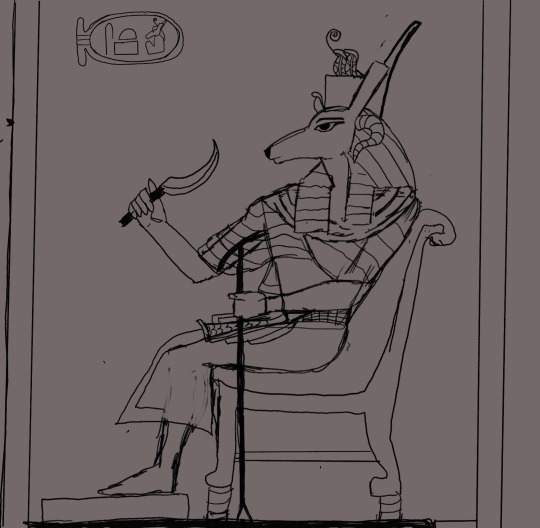
Set was the lord of the Red-Lands and Upper Egypt to start. After Osiris got capped and he (rightfully) inherited the Throne of Lower egypt into his domain and power. The god of violence, expanded his influences as far as it could go before the disappointing end of the myth. Taking Kush, Punt, Canaan, edging into Parthia, tickling the feet of the Hittites, and standing firm in northern Africa, taking control of any and all trade of the Mediterranean south. Formally Creating the first Egyptian Empire from this:
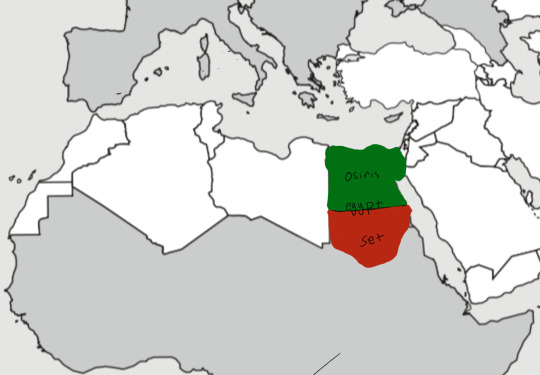
To this!
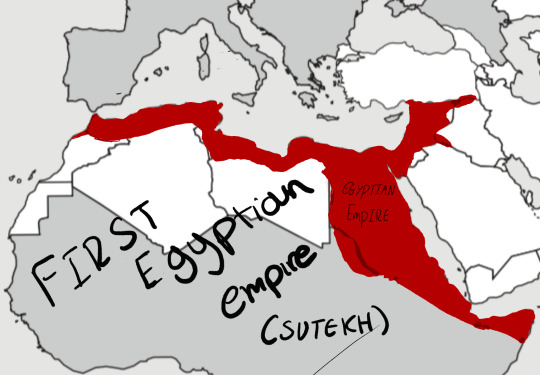
Within his 90-80 year reign, Set grew his empire Substantially. Ruling over a multitude of different peoples, who gave him different names and accepted him into his pantheons (Baal, Hadad, Teshub, etc).
Set’s direct power over the southern Mediterranean brought extreme wealth to his new Egyptian empire, and an influx of slaves, diverse traders, peoples, and a wealth gap to be introduced to the former somewhat closed off kingdom of egypt. The poor were extremely poor, and the rich were extremely rich. Though, he introduced reforms, which the ancient world weren’t yet ready for, as I listed before in a previous post.
As you can seen the reasons Isis knew Horus could no win waging war or in a fight one to one was fairly simple. Set was Infinitely stronger than Horus, and he had hundreds of the thousands of men from different lands marching at his back, solely loyal to him as their great new god. Set does eventually get occupied with Horus battle stuff and cannot enjoy fighting at the two fronts of his expansion and was planning to conquer Mesopotamia before Horus challenges him pausing and effectively ending all expansion in his reign.
Egypt would never see such Expansive success again until the likes of his Grandson Rameses the Great.
…
At the end of the Myth there was massive losses to Egypt, returning it from empire to Kingdom, The gods agreed that the lands Set had rightfully conquered were not to he included in Horus’s inheritance (which pissed off the spoiled little shite), who proceeded to lose Punt due to his inexperience and mismanagement. Leaving the once massive empire looking more like this:
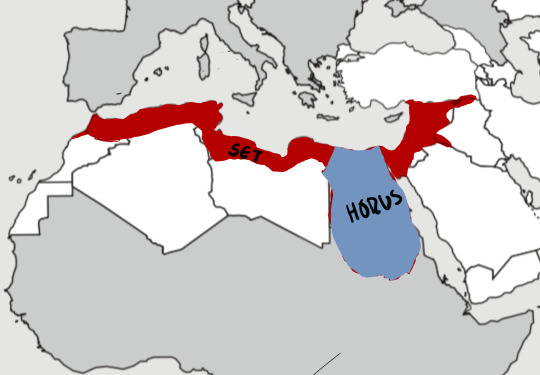
L Horus PERRR Usual! Set remain Lord of the red-lands for a another millennia or so, before eventually retiring to become Ra’s heir upon the sun boat, allowing for his Foreign people to be ruled by his descendants. The remains of his once great empire were ruled by Wepwawet, then Maga for some time, before giving it to the Mortal Kings of Canaan and Northern Africa, like Horus in egypt.
The Wives:
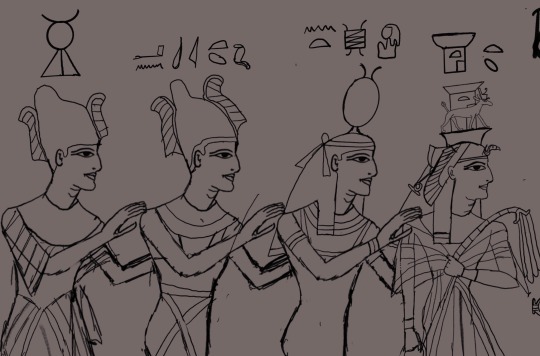
Set has many wives, but these are the Great wives:
Nephthys, Neith, Anat, and Astarte.
Nephthys is Set’s Great Wife to begin with, being the mother of the Most of his divine offspring and his first love.
After the Murder of Osiris she was admittedly afraid. (She is rather delicate when it’s other gods making the trouble, especially her world ending, unkillable snake and brother murdering husband).
She becomes depressed thinking of her windowed sister, having taken her place as Queen. Her pity had only festered with everyday, she having seen Isis sprinting after her trapped husband, and watched as Isis aggressively shaved her eyebrows off in a spell of horrid grief when she was unable to save him.
So she remains at Set’s side while Harboring as she worked to Isis back to a sense of sanity and reality , slowly becoming a insider to help her find Osiris’s body. Nephthys successfully does find the location….but Set wondering why his wife was being so distant discovers this, and tears up Osiris’s body, setting them back at square one. When he returns home to yell at her again, she’s already hit the ground running and books it out of Egypt with Isis and baby Anubis on Set’s ship. She does return to Egypt eventually keeping low and raising Anubis and Horus, before getting pregnant after Seducing Set into telling her secrets with the help of coitus, unconsenstually administered drugs and worrying amounts alcohol. (She is 1000% on all the registries).
—-
Neith becomes Great Wife a few years after Nephthys escapes. Before assuming the title she had spent her time seducing and distracting him from his search for Isis while Nephthys harbored her. Encouraging him to expand the empire and Has Sobek (who later eats a piece of Osiris, and gets jumped by Horus and Isis) to keep him happy. Once Nephthys leaves and she becomes great wife, she struggles to keep him from looking for the escaped trio, and ultimately fails when Set discover Horus’s existence and she just books it to Canaan while pregnant with Serket to escape Set’s wrath, and for the safety of her children, ultimately laying low until the final trial.
Anat and Astarte are set’s great wives only briefly after the end of his empire, producing Maga before Set’s reconciliation with Nephthys and Neith, which gets them unwilling deposed to lesser wives.
The Children
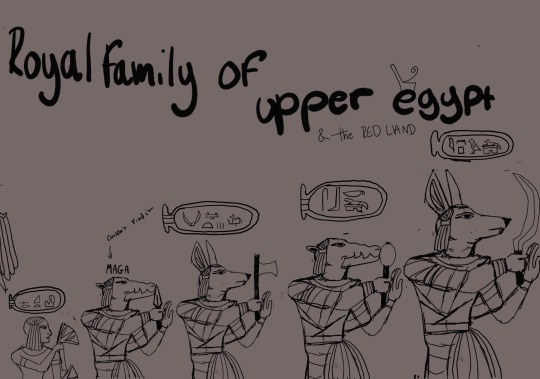
Set’s children throughout the Myth is:
Anubis, Sobek, Wepwawet, Maga, and Serket. (In order of birth)
Nephthys: Anubis, Anput, Wepwawet, and Bata (born after the original myth)
Neith: Sobek and Serket,
Anat and Astarte: Maga (they both act as his mother, in reality he is Astarte’s son, but Anat takes a role as his second mother, she bears no interest in bearing children)
Anubis and Sobek, were both once considered the heirs to the Empire’s before their disappearances with their fleeing mothers. Here I display the children each bearing a weapon gifted to them by their father, with a Serket bearing two lotuses in references of a personal head-cannon story of mine:
Set looks throughout his new empire, journeying across it as he looks for Isis and Horus. In his travels he comes upon Serket, while ignorant of their relation to each other, she unlike all others is unafraid of Him the slayer of Apep and Murderer of Osiris. She simply offers the Pharaoh a Blue Lotus, and Set perhaps wanting to be a prick or sensing the oddity of the little one. Crushes the lotus in his hand and mends it with sand squeezing the magic of the lotus from its leaves, before opens them to reveal a Scorpion, he gifts it to Serket, who accepts the creature and becomes it’s master.
Spent the whole school day writing lore instead of doing my work…ahaaaaa
#ancient egypt#nephthys#set#set x nephthys#neith#set sutekh#set x neith#setgodofchaos#god anubis#magah#maga#Serket#Sobek#Wepwawet#Ancient Egyptian mythology#personal canon#Personal lORE#MyCANNNON#need coffee
5 notes
·
View notes